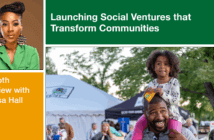Ann Michel of the Lewis Center staff suggests that in an age of rampant religious disaffiliation our evangelistic task in the Advent and Christmas seasons may go beyond gathering in less-frequent church attenders, friends, family, and neighbors. She sees a need to help a generation of dechurched young people reclaim the sacred aspects of Christmas and offers ideas for rebuilding religious memories starting in the places where life happens.
I grew up in a nominally religious household. But not at Christmas time. At every family get-together we sang Christmas carols, including every verse and stanza of the sacred hymns of the season. We knew them all by heart. It was one of two times a year when we prayed at the table, the other being Thanksgiving, of course. And attending Christmas Eve services was an inviolable tradition, even for visiting friends and family who didn’t worship at any other time of year. Fast forward a generation or two. Last Christmas it dawned on me that some of the young children in my extended family probably don’t even know that Christmas is a celebration of the birth of Jesus.
If your church is anything like mine, your pews are full of parents of adult children grieving the fact that their millennial offspring have left the church. And their grandchildren are likely to be largely dechurched. Their decorating, merrymaking, gift-giving, and wearing of silly themed pajamas occurs without any connection to the reason for the season.
Adding a new dimension to our evangelistic task
The church has long been forced to compete with secularized holiday rituals. Yet at the same time, Christmas has always been an opportunity for a great “gathering in” — a time to welcome back less-frequent church attenders, friends, family, and neighbors and to reacquaint them with the sacred story of God’s Word made flesh. Fortunately, even in our post-attractional era, that is still true. But in an age of rampant religious disaffiliation, our evangelistic task in the Advent and Christmas seasons may require an additional dimension. What if we didn’t focus all our energy on gathering lost sheep into the fold at Christmas but also helped people reclaim the sacred aspects of Christmas within their homes and families? Instead of a great gathering in, what if we thought about the lessons of Christmas flowing out to the places where life happens?
Sharing the meaning of Christmas in the places where life happens
This may be easier at Christmas than at any other time of year since so many secular holiday rituals have their roots in the sacred tradition. Your best options will be activities that draw on the unique gifts of your congregation and the needs of your community. But here are a few ideas to start your thinking.
1. Host a community wreath-making workshop.
Advertise it as a way for people to decorate their homes for the holiday, and consider holding it offsite or perhaps outdoors. If no one in your church can lead this type of event, consider engaging an expert from a garden center or craft store and charge a small admission fee to cover the costs. Include a station for making traditional Advent wreaths and send each participant home with an Advent wreath and a booklet of prayers and readings to accompany the lighting of the Advent candles.
2. Equip parents and grandparents to share the Christmas story.
Families that have fallen out of the habit of attending Christmas worship are still looking for novel ways to engage and entertain children who become more eager and excitable as Christmas draws near. Ask your children’s ministry leaders to assemble a list of children’s books and stories focused on the spiritual meaning of the holiday. Consider videotaping brief children’s messages. Compose a series of special prayers that parents can incorporate into their bedtime rituals as the holiday nears. Rather than distributing these to just the people already in the pews, share all these resources widely through social media.
3. Share the sacred music of the season.
Starting in late October, every retail establishment in America plays a continuous loop of “Jingle Bells,” “Frosty the Snowman,” and “I’m Dreaming of a White Christmas.” But many children today don’t have the opportunity to learn the sacred Christmas carols that were part of my childhood. Prepare or purchase simple songbooks with the words to beloved Christmas hymns — “Joy to the World,” “Silent Night,” “O Little Town of Bethlehem,” “Hark! the Herald Angels Sing,” and so on. Many Christian booksellers offer such songbooks for a very modest price. Host a community carol sing or send carolers door to door in your neighborhood, giving these songbooks as a holiday gift. If you have a high-quality music ministry in your church, record Christmas carols and post them to social media where people can share them with family and friends.
4. Demonstrate the true spirit of giving.
Holiday gift-giving is deeply engrained in secular culture. But the annual frenzy of shopping, wrapping, opening, and returning gifts too often reflects the worst aspects of our consumerist culture and forges a “gimme, gimme, gimme” attitude in children. Parents are often desperate for a different way. Help parents who want to teach their children the true nature of generosity by providing opportunities for children to give to others. Maybe it’s a Breakfast with Santa where children offer gifts to Santa to be shared with other children instead of telling Santa what they want for Christmas. Maybe it’s an intergenerational event where children can craft simple and heartfelt gifts for family members. Maybe it’s a community service opportunity or alternative gifts market. Many charities compete for people’s attention during the holidays, but the church has a unique message to share in explaining the generosity of a God who gave us his only Son and why we give at Christmas.
Rebuilding religious memory
In years gone by, the Advent calendars I gave to my own children were the kind with small chocolate icons behind 24 windows on a cardboard Christmas tree. Their Advent calendars could be a sweet treat since they were learning the Christmas story at church, in Sunday school, and in their church-related school. This year, I bought a different kind of Advent calendar for my four-year-old granddaughter. A felt nativity scene complete with shepherds, a star, a donkey, a manger, animals, Mary, Joseph, and a baby Jesus. And I prayed a prayer that the Spirit would be with us in this Christmas season.
We live in an era when we can no longer assume that people’s religious memories will draw them back to church at Christmas. So, perhaps our task is to rebuild people’s religious memories from the ground up, starting in the places where life happens.
Related Resources
- Add Off-Site Christmas Eve Services This Year by Mack Strange
- A Birthday Party for Jesus by Margie Briggs
- 10 Ways to Reach Unchurched People at Christmas by Carey Nieuwhof






